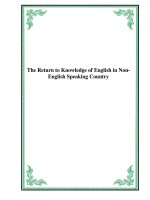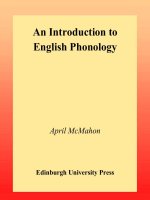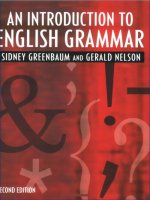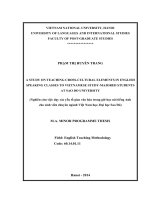Introduction to english speaking countries
Bạn đang xem bản rút gọn của tài liệu. Xem và tải ngay bản đầy đủ của tài liệu tại đây (87.16 KB, 10 trang )
Introduction to English-speaking Countries
(Lesson Outlines)
by Todd Owen
Background
Foreign teachers at Chinese universities are sometimes asked to teach a course with a
name such as "A General Survey of English-speaking Countries", or "An Introduction
to English-speaking Countries", or similar. I taught this course for a semester in 2003,
and found the lesson preparation quite overwhelming. This was especially the case
since I was given very little guidance and no clear objectives. In the hope that it might
be of some assistance to other teachers who find themselves in a similar situation, I
have collected together some notes on how I ran the course, and the Microsoft
Powerpoint presentations which I used during the lectures. Of course, I do not expect
that any teacher would follow these notes to the letter, since their own lessons will
naturally be influenced by their individual expertise and their ideas about teaching.
I would like to make it clear that this is not an ideal teaching plan, and if I taught the
course again I would certainly make some alterations. But I will describe the course as
I taught it, in the hope that others can learn from my mistakes as well as my successes.
Course Structure
The course was for second-year English majors. There was a textbook assigned,
written in English by a Chinese author, that focused mainly on geography, history,
economy, and government structure. I asked the students to read this outside class,
while my lectures were largely unconnected with the textbook. There were several
reasons for this: firstly, the textbook was dull; secondly, my own knowledge of these
subjects was no deeper than the textbook itself; and thirdly, I thought that since I had
personal experience of Western culture which most of the Chinese teachers lacked, I
should find a way to incorporate this into my classes. That said, I did sometimes
summarise the book's content, to help my students see the "big picture".
Lessons were given in a multi-media lecture theatre, with two classes (more than 60
students) attending at the same time. With so many students, it would have been
difficult to manage groupwork or host class discussions, and so I adopted a lecture
format. But a further problem was that it was beyond my ability to even find enough
topics to fill two 45 minute lectures each week, let alone prepare material for them. So
instead I spent only the first period presenting a lecture, and during the second period
(which always directly followed the first) I showed films that were relevent to the
course. I based my lectures around Microsoft Powerpoint presentations, and thus
relied on both the computer and the DVD player that the classroom was equipped
with.
Looking back now, I wonder why I did not allow some class time for students to read
the textbook, or perhaps to cooperate in groups by each reading a part of the textbook
and summarising it, and why I did not spend more class time discussing the answers
to the homework assignments. I think that due to my background as a university
student in Australia, I saw such activities as unsuitable for class time. But in China,
the ratio of "contact hours" to "non-contact hours" is quite different to Australia, and
in hindsight the amount of work that I asked my students to complete outside class
was higher than many of their other courses.
Assessment
The components of the final mark were: 10% homework assignments (marked for
completion, not correctness); 30% group assignment; 60% final exam. The final exam
was multiple choice, with questions based on both the homework reading and the
lecture material. I designed the exam to test general, conceptual understanding rather
than specific details like dates and numbers.
Exam Information
Information about the exam format, and several example questions.
Textbook and Homework
Each week, I asked the students to read a section of the textbook and answer some
questions. The questions were designed to help them understand and summarise the
content of the textbook. At first I planned to only collect every second week's
homework, but I had to admit to myself that unless I collected it every week it was
wishful thinking to expect any significant proportion of students to do the work. At
the beginning of the semester, what I received from most students was simply a few
paragraphs copied word-for-word from the textbook, with no indication that they had
understood or even read those paragraphs. In many cases, it was not even copied from
the textbook, but from a classmate.
I prohibited both copying from the textbook and copying from other students. I
sometimes wrote comments, but in general I did not mark the homework for
correctness, since my collecting it was only a means to ensure that the students did the
work, not a means of assessment. Of course the homework was still worth a small
proportion of the marks for the course, and this was based simply on whether or not
the homework had been completed, and whether it had been copied or not. Merely
checking whether each student's homework was their own work or not became a
major burden on my time, considering that there were some 120 assignments to mark
each week.
Each week I selected the best answers to each question, photocopied them, and pinned
them in each classroom (the fixed classroom for each class, not the lecture theatre). I
preferred this to writing "official" correct answers myself.
The textbook was An Introduction to Britain and America (Lai Anfang Ed.), published
by Henan People's Publishing House. It's a small book with the Statue of Liberty and
a map of England on its blue cover.
The details of the homework tasks are contained in the files below:
Homework Hints
Notes about how I expected the students to carry out the homework tasks.
Powerpoint presentation
Homework Assignments
(html preview)
Homework questions for each week.
Powerpoint presentation
(html preview)
Model Answers
Answers to the homework questions, selected from students' assignments.
Word document
(html preview)
Group Assignment
Towards the end of the semester, I asked the students to arrange themselves into
groups of four, and produce an A3 poster on a topic related to the course (I supplied
each group with cardboard to use as a backing). Of course it was my hope that each
group member would contribute to the project, although I have no way of knowing
whether that was the case or not. Every group in the class had to choose a different
topic (I helped them to organise this), and after marking I pinned the posters up in the
respective classrooms so that students could admire and learn from the work of their
classmates.
The topics I suggested were: Festivals, Religion, Social Problems, Sport (UK), Sport
(USA), Famous Places (UK), Famous Places (USA), Canada, New Zealand, and
Australia. But students were also able to invent their own topics, subject to my
approval, and some that emerged were Movies, Music, and Food.
Poster Marking Guide
I provided this to the students in advance, requiring them to write their names on it and submit i
Word document
(html preview)
Example Poster: Weddings
I printed this, cut it up, and stuck the fragments onto cardboard with appropriate titles an
somewhat minimal) of what I expected from the students.
Word document
(html preview)
Lectures
The Powerpoint presentations listed below are by no means complete lesson plans.
They only contain the core points which I discussed in my lectures. They are provided
"as is" here, in case other teachers find them useful in planning their own course
outline, and lessons.
Most of the images used in these presentations were found on the internet.
Unfortunately, due to my own lack of foresight, I did not record the relevant copyright
details at the time I downloaded the images.
The text itself is copyright 2003 Todd Owen. Permission is given for it to be used
freely.
Week 1: About the English language
Where English is spoken; its history; its significance in the modern world.
(no presentation available)
Week 2a: Social Structure
Corporate capitalism; social inequality and class; families and households.
Powerpoint presentation
Week 2b: Australia
(html preview)
Facts and trivia about my own country. Includes the lyrics to a well-known Australian song, w
then invited them to follow me in singing.
Powerpoint presentation
(html preview)
Week 3: Religion
Christianity and its history; religion in Britain and the USA; the troubles in Ireland.
Powerpoint presentation
(html preview)
Week 4: Political Systems
The political systems of the USA, UK, and Australia described and compared. Constitution;
America's "checks and balances"; the two party system.
Powerpoint presentation
(html preview)
Week 5: Communication Between Cultures (1)
These three weeks of lectures were based on the book "Doing Culture", written by Linell D
Language Teaching and Research Press in Beijing. In fact, this was to be the textbook for a co
do in third year, but I saw no harm in introducing the principal concepts earlier. Be warned, ho
cover, and some of my students found some of the examples of Chinese culture given in the bo
same limitation of any book on culture, in that it deals with generalisations). I found it very enli
from the class.
This first lecture introduced the idea of culture; visible and invisible aspects of culture; and high
Powerpoint presentation
(html preview)
Week 6: Communication Between Cultures (2)
More about high and low context cultures; formality; "Dinner with Friends" case study.
Powerpoint presentation
(html preview)
Week 7: Work Culture
Culture in the workplace; large versus small power distances; "Four Secretaries and Their Jobs"
Powerpoint presentation
(html preview)
Week 8: Drinking; Smoking; Dating
Occasions when alcohol is drunk (not much different to China!); popular kinds of alcohol; s
customs.
Powerpoint presentation
(html preview)
Week 9: English History
The class had finished reading the chapter of the textbook devoted to Britain's history, so I spen
and at the same time trying to inject a bit of interest by briefly retelling two legends (accompani
The first slide gives a list of events, which I asked the students to put into order, without lookin
require them to recall the exact dates, though). Then I drew a timeline on the board (700BC to 1
it. The answers are: arrival of the Celtic people (about 700BC, the Celts were however not the
invasion (Julius Caesar 55–54BC, but it was Claudius in 43BC who genuinely conquered t
Anglo-saxon invasion (5th century AD), Norman invasion (1066), Magna Carta (1215, King Jo
Montfort), Peasant uprising (1381, not listed on the slide), Republican government of Olive
Revolution (late 18th century), The Chartist Movement (1836–1848), The First World War (191
Powerpoint presentation
(html preview)
Week 10: Festivals
Christmas; New Year's Eve; Easter; Thanksgiving.
Note that slide 17 is intentionally left blank: at this point, I paused to ask the class what other
which countries Thanksgiving is celebrated (the short answer is that Thanksgiving is a US festiv
Powerpoint presentation
(html preview)
Week 11: Special Occasions
Birthdays; weddings; funerals.
This presentation includes a wedding photo featuring my friends Lukasz and Amy, which you
regard to birthdays, note that in the Chinese version of the "Happy Birthday" song, the same ly
in the English version the third line varies.
In fact, when I gave this lecture I stopped after describing wedding customs, because I wa
Weddings and a Funeral". The funeral in this film does not occur until the second half, so I de
just before continuing the film.
Powerpoint presentation
(html preview)
Week 12: Food and Drink
Breakfast; lunch; dinner; fast food; sweet foods; drinks.
Powerpoint presentation
(html preview)
Week 13: Art and Literature
Drama; opera; musical theatre; novels.
Powerpoint presentation
(html preview)
Week 14: Entertainment and Sport
Popular English, American, and Australian sports; descriptions of rugby, cricket, baseball, A
Aussie rules football, and golf (note that in China only the wealthy can afford to play this spor
in China and hence need no introduction.
Powerpoint presentation
(html preview)
Week 15a: Recreation
Meeting places (restaurants, cafes, bars); movies; music styles.
Powerpoint presentation
(html preview)
Week 15b: Education
Compulsory education; university; typical number and type of classes; differences between e
year.
Powerpoint presentation
(html preview)
Week 16: American History (An Overview)
Native Americans; the American Character; Western expansion; the Vietnam War; the Cold War
As with the English History lecture, I began with a list of events, asked the students to put them
a timeline (1607 to today). The answers are: War of Independence (1775–1782), the purchase o
start of expansion to the west (continuing until about the time of World War I), Civil War (186
the start of the Great Depression (began in 1929). I kept this timeline on the board, and lat
Jamestown in Virginia), the second colony (1620, at Plymouth), the Boston Tea Party (1773), t
the establishment of the Constitution (1787), the second war with English (1812), and the Mexic
Powerpoint presentation
(html preview)
Films
Despite the large number of DVDs available in Chinese cities, finding films
appropriate to a course like this one is not easy. For reference, the films that I showed
are listed below. Since the aim was to understand the cultural content, not challenge
their listening comprehension, I usually turned on the Chinese subtitles (but played
the English soundtrack). I explained the reason I was showing each film, paused it
from time to time to ask questions or point out things of historial or cultural
significance, and in some cases drew a history timeline on the board.
Bend It Like Beckham
Feelgood comedy which deals with multiculturalism in England.
Elizabeth
The life of Queen Elizabeth.
Far and Away
Scenes from frontier America, with the Oklahoma land race as its climax. (Since this is rather
middle). I used the following presentation to provide background information:
Powerpoint presentation
(html preview)
Forrest Gump
A film spanning the important historical events of the baby boomers' generation in America.
film in China, and many of my students had watched it before).
Four Weddings and a Funeral
A romantic comedy with numerous examples of wedding and funeral customs.
Michael Collins
The story of Ireland's violent struggle for independence.









